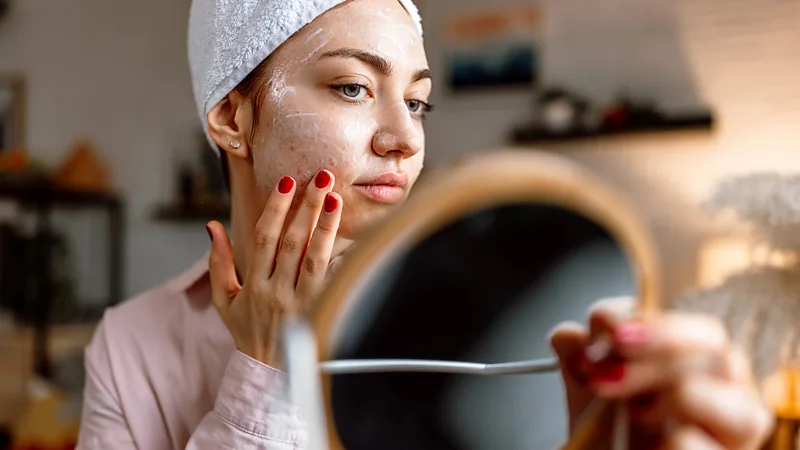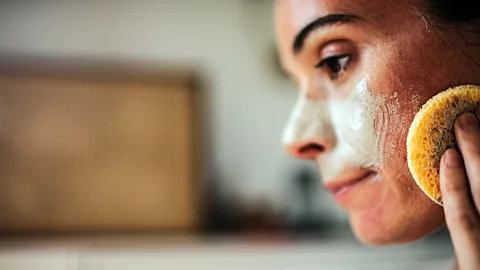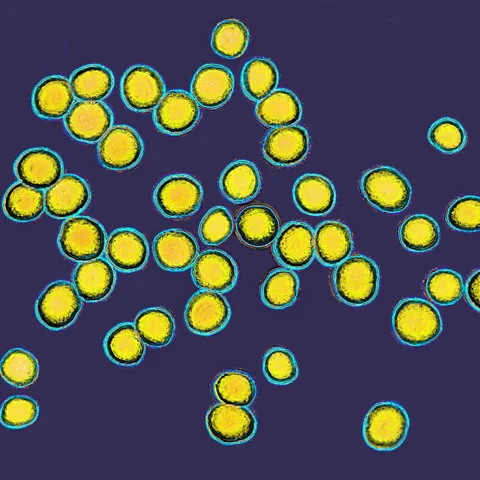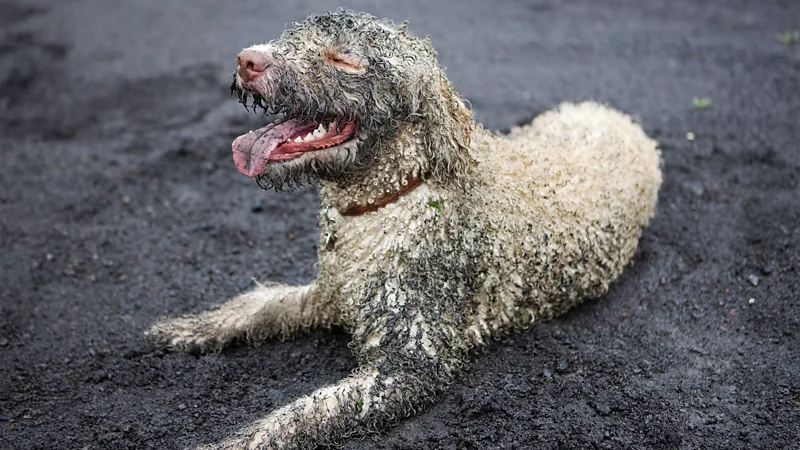Do skin probiotics actually work?

The bacteria and fungi living on your skin play a surprising role in keeping us healthy. Is it possible to give them a boost?
Scratch the surface of the skin, and you'll find a bustling community of bacteria living there. This is a good thing, as research increasingly shows that having the "right kind" of microbes can help keep our skin young, supple, and smooth for longer. Simply by being there, "good bacteria" protect us from infection from pathogenic, harmful microbes. They also help to repair wounds and may even counteract some of the harmful effects of UV rays.
All-the-more reason to look after our skin microbiome. But how do we do this? One method that has become increasingly popular is the use of topical skin probiotics – which technically means applying live microorganisms to the skin to improve its health.
As far back as 1912, scientists were rubbing bacteria into people's faces in an attempt to improve conditions such as acne and seborrhea – a common form of dermatitis that causes a red, itchy rash and white or yellow scales.
Today there are dozens of skincare companies selling what they describe as probiotic products, from serums to cleansers and moisturisers. In each case, the balms offer to rebalance the delicate skin microbiome, leaving it "renewed" and "refreshed".
But while skincare products often claim to be "probiotic", very few, if any, actually contain live bacteria.
What's more, as probiotic skin treatments are classed as "cosmetics" and not medicines, their manufacturers don't have to share the results of any trials that have been conducted on their products, so it's difficult to know how effective they are.
"The rules around skin care products are very different to the rules around drugs, so claims can be made with less rigorous testing than would be made for a pharmaceutical agent," says Richard Gallo, a dermatologist at UC San Diego School of Medicine.
Most "probiotic" skincare products contain either prebiotics – nutrients that feed and encourage the growth of good bacteria on the skin, or postbiotics – proteins or other products made by beneficial bacteria.
"What we are seeing more and more are approaches that try to influence the microbiome," says Bernhard Paetzold, co-founder and chief scientific officer of S-Biomedic, a company that aims to treat conditions by restoring the skin's microbiome through bacterial "transplants".
According to Paetzold, the main reason for this is that live bacteria are extremely difficult to keep alive throughout the manufacturing, storing and distribution process. Once on the skin there's no guarantee that they'll even take hold, as they must fight to compete with the millions of other microbes already living there.

The idea of promoting a healthy skin microbiome is rooted in the theory that bacteria and fungi living on the outside of our body help to protect us from those that might do us harm.
Yet the science behind how certain "bad" bacteria can contribute to skin diseases isn't yet fully understood. What we do know is that people with eczema, rosacea, acne and psoriasis all have different types or levels of certain bacteria living on their skin.
"What exists at the moment is a lot of papers showing that nearly every skin disease imaginable is associated with a shift in the skin microbiome," says Paetzold. "But this observation just shows an association. It doesn't say that the shift in the microbiome causes that disease. It could also be that the disease changes the skin environment, and that's why the bacterial population changes."
To prove that a particular strain of bacteria is causing a disease, you would need to either give a healthy person that skin disease by slathering the "bad bacteria" on their face, or cure their disease by applying "good" bacteria. While the first option is likely to encounter ethical barriers, there are a few researchers attempting the latter.
The limited clinical trials that have been published, however, do show promising results. Most focus on using live bacteria to treat eczema, also known as atopic dermatitis. They are based on the findings that the skin of people with eczema is dominated by Staphylococcus aureus, a bacterium that can often be pathogenic.
"One of the big problems in the skin for diseases like eczema, is that certain pathogenic bacteria like S. aureus live on the surface of the skin and cause rashes, cause disease, and cause infection," says Gallo, whose own research group has been searching for ways of harnessing the skin microbiome to fight off the harmful bacteria found thriving on eczema patients. "We mined the bacteria types that usually live on healthy skin looking for bacteria that could produce things that would fight off those bad bacteria".
Gallo's are focusing on Staphylococcus hominis, a naturally occurring skin bacterium which is present in 21% of healthy people, but only 1% of atopic dermatitis patients.
"Our skin provides commensal bacteria like S. hominis with a safe place to live, so some of them have evolved a way of protecting their environment from these bad bacteria that are trying to invade," says Gallo.
In the case of S. hominis, the bacterium produces anti-microbial peptides – small fragments of protein – which directly kill S. aureus. They also produce chemicals called "autoinducing peptides", which stop bacterial cells from communicating with one another. Some bacteria like S. aureus signal to one another when their population density reaches a certain level – a mechanism known as quorum sensing – triggering the secretion of toxins that can cause skin inflammation. Disrupting that communication can prevent the toxins from being released.
In 2021, Gallo's team conducted a phase one randomised controlled trial with 54 adults with atopic dermatitis by applying a cream containing live S. hominis over the course of one week. The results showed that treatment with S. hominis dramatically reduced S. aureus colonisation, and even decreased the redness and itch associated with atopic dermatitis in a subgroup of patients compared to a control group given a placebo cream.
The findings suggest that using special formulations of living bacteria could well help to make the skin's microbiome healthier. But more work needs to be done to prove its effectiveness before it can be used as a treatment. The team are now recruiting for a phase two randomised trial which will assess the efficacy of the treatment over a longer 14 week timescale.
Elsewhere, other researchers have also had success treating eczema with probiotics. In one 2003 clinical trial, 11 patients with atopic dermatitis were given a cream containing the bacterium Streptococcus thermophiles, which they applied for two weeks. The results showed that the cream enhanced the skin's production of ceramides – lipids that help to keep the skin hydrated and maintain it as a healthy barrier.
More recently, in 2018 10 adults and five children with atopic dermatitis were given a "microbiome transplant", where live Roseomonas mucosa bacteria collected from the skin of healthy volunteers was then applied to the skin of the patients twice a week. After 16 weeks, the treatment improved their symptoms by more than 50%.

Although clinical trials focusing on other skin conditions are somewhat rarer, they also show promising results. Acne, for example, is linked to colonisation by the bacterium Cutibacterium acnes. Some researchers are therefore looking for bacteria that produce antimicrobial peptides to inhibit or kill this bacterium. In one clinical trial, a lotion containing the bacterium Enterococcus faecalis was given to patients suffering from severe acne. The lotion significantly reduced pustules compared to a placebo lotion.
Paetzold and his company S-Biomedic, meanwhile, published a clinical trial in 2019 where they gave patients with acne a cream containing specific strains of Cutibacterium acnes. The results showedsome reduction in acne.
Gallo is also researching whether a strain of Staphylococcus capitis bacteria could be an effective acne treatment, with studies in animals showing promising results.
"The basic mechanism of action is very straightforward. It just inhibits the C. acnes growth, much in the same way that topical antibiotics or oral antibiotics are used to treat acne," says Gallo.
Unlike topical antibiotics, however, the treatment specifically targets C. acnes, so the wider skin microbiome is left unharmed, he says.
Gallo's team has even found a specific strain of Staphylococcus epidermidis bacteria that produce molecules that may inhibit the development of sun induced skin cancer.
"It generates a small molecule that inhibits DNA synthesis in transformed or mutagenic skin cells," says Gallo. "We've found in
that if these bacteria are present on the surface of mice that undergo UV radiation damage, they get far fewer skin tumours than mice that have the same species of bacteria, but not the genes [in the bacteria] that make this anti-metabolite."
Of course, such a treatment will have to go through much more testing and clinical trials before it can be shown to have a similar effect in humans.

While most studies have looked at treating specific diseases with probiotics, there are also a few that have examined whether pre- or postbiotics could improve skin health generally. For example, some researchers are looking at whether inulin – a dietary fibre frequently found in cosmetics and personal care products – could serve as a prebiotic when taken as an oral supplement or applied topically to the skin. Preliminary results suggest that inulin makes the skin more smooth and supple, providing a more favourable environment for beneficial bacteria to thrive. Other studies have shown that slapping on sphingomyelinase, an enzyme produced by bacteria such as Staphylococcus thermophilus – which are commonly found in fermented milk products and yogurt – can boost production of ceramides, which are needed to keep the skin healthy.
However in all cases, large randomised double blind clinical trials – the gold standard of medical research – are needed to confirm whether any of these creams are effective.
For example a recent review study examined all of the data from clinical trials conducted to date and concluded that while "oral and topical probiotics appear to be effective for the treatment of certain inflammatory skin diseases and demonstrate a promising role in wound healing and skin cancer, more studies are needed to confirm these results".
Gallo agrees that more work is needed but is hopeful about the future of the field.
"It's moving in the right direction," he says. "We've come to realise as a field that we need to understand what exactly they're doing, and there's a lot of efforts being put into that, as well as other ways to design microbes to help benefit us. So I'm very optimistic about where we'll be in a few years with probiotics."
However for people who don't have a skin disease, but who might want to increase the smoothness of their skin, prevent wrinkles, or boost hydration levels, there is little evidence that probiotic creams readily available in shops will have any benefit.
"I think many of the probiotics on the market now don't have very strong evidence behind them, so I wouldn't recommend those necessarily," says Gallo. "You can try them – but it might not be the best use of your money."
While your skin microbiome changes as you age and encounter different environments, there are a few things you can do to help your skin's natural microbiome flourish.
"It's a two-way street, because the types of things that we're already doing to moisturise our skin or protect the skin from UV damage are creating an environment that's more hospitable for these beneficial organisms to live in," says Gallo.
"So normal skin care, appropriate moisturising and cleansing – all of those things will promote skin health."
--
Source: BBC

















































:max_bytes(150000):strip_icc():format(webp)/Health-Dandelion-Tea-e277b26a239a4a48aa56f1e7cbbff9e5.jpg)






